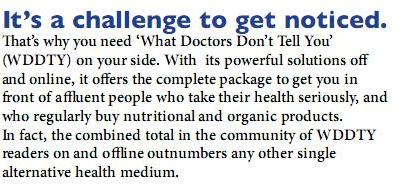Or How Wandering Teacake Wasted His Time Trying To Understand WDDTY’s Sales Figures
26th October 2014
It’s been a while since I’ve written about What Doctors Don’t Tell You, the journal of record for those looking for an alternative to real medical advice. But here I am, pretty much back where I started my blogging career all those 12 long months ago.
Here’s why. Over the past 18 months or so, various individuals, myself included, have contacted various supermarkets and newsagents that stock WDDTY, expressing our concern at the content of this – how can I put it? – festering purulent pile of discarded, discredited and dangerous treatments. Over the years, some stockists have dropped the title, some have dropped it and then reportedly started again, some have just ignored us. But through it all, the editors of WDDTY have screamed about free speech and how the nasty Big Pharma shills want this magazine banned.
Also, over the past couple of months, those of us unfortunate enough to be on the WDDTY mailing list have been seeing increasing numbers of marketing e-mails coming from WDDTY HQ. Not only is the frequency increasing, but there seemed to me an increasing note of desperation creeping in to the content.
So, I thought it might be interesting* to take a look at the sales figures for WDDTY and see if anything has changed as a result of the goings-on over the last year.
* not interesting
As luck** would have it, I wrote a post last November about how the magazine, despite protestations that they would never take advertising because they wanted to stay pure, now carries as much advertising as any conventional publication. As part of the background for that piece, I posed as an advertiser and obtained a copy of the advertising rate card then in use. This is the document WDDTY uses to tempt potential advertisers, the claims they make in order to sell space in the magazine.
** misfortune
So, going undercover again, I have obtained a copy of the latest rate card, now renamed (for reasons that will become clear) “Media Pack.” We can have a look and see what claims WDDTY are currently making, and if all the hoo-ha over “banning” the magazine has had any effect on sales.
N.B. I haven’t attached either the old or new rates cards to this article, because I don’t want the publishers going all copyright-y on me. If you want to have a look at these documents for yourself, I’m sure their advertising department will be happy to oblige – speak to Paul Barrett on paul@wddty.co.uk. You may have to pretend to be a seller of homeopathic underwear or something, though.
Here we go.
Looking at the latest media pack, it’s immediately clear that the focus has changed. Where the previous version gave information about the magazine, the categories of subject it covers, and the sales figures, the new version goes all out with the marketing bollocks.
Readers are the commodity being sold, and the magazine and website are merely the vehicle to deliver those readers to any advertiser wanting to boost their “sales and brand.” The old rate card devoted a large proportion of its space to a list of the categories of subject covered in the magazine. That’s now gone, replaced by a list of reader interests.
It’s all about marketing to the readers. If you were looking for a clear indication of what WDDTY are about, and what they think of their readers, this is it. Bugger trying to be a voice of reason, it’s all “powerful solutions” this and “get you in front of affluent people” that. Remember, their own website claims this:
That paragraph seems hard to reconcile with what we’re seeing here. And remember this from the Times..?
Pure, eh? Given how much WDDTY’s editors bleat about the supposedly Pharma-funded campaign against them, it’s enlightening to see how much they are just a glossy front for their advertisers.
It’s also worth briefly mentioning that, while the old version included a list of supermarkets and stores that stocked WDDTY (including Waitrose, which they later denied had ever been a stockist when Waitrose sensibly dropped them), the current media pack lists no stores. This is probably wise, since the list keeps changing.
So let’s have a look at some numbers, shall we? Maybe even have a graph?
Before we get to that, I should take a moment to address a particular portion of my audience. I know most of you are health or science nerds and that, as a result, you don’t view the prospect of a graph with trepidation. But I do occasionally get a few peddlers of alternaïve*** treatments coming in to my blog looking for things I’ve written that they can repeat back to me like I’ve forgotten I’ve written them, so in the interests of inclusiveness I’d just like to address that one part of my readership for a moment.
*** That’s a new term I’m inventing there.
Homeopaths: Hi there. I know you guys don’t really do numbers. I know you’re not really alongside the concept of research. Or critical thinking. And I know you’re particularly suspicious of the idea that somebody can take some published figures and analyse them, write about them, maybe even make a graph of them. You think that’s cheating. But I don’t want to lose you here, so I’ll tell you what. The rest of us can go and have a look at those numbers and graphs, and if you guys prefer you can have a look at this picture of a cat in a hat instead.
We’ll all meet up again at the end of the page.
The Numbers Game
Where was I? Oh yes, the numbers. If you remember, I want to see if the sales figures have been affected by the hysteria over possible “banning.” It’s difficult to make a direct comparison between the old figures and the new, because they are quoted differently, but I’ll do my best.
Here’s the original:
And here’s the new
As you can see, the numbers aren’t broken down in quite the same way, so it’s not possi- wait, what?
Not only is that a rather specific figure (if you’re a homeopath who, inexplicably, has wandered in from staring vacantly at the cat, have a look at this GCSE Bitesize guidance on significant figures) it’s huge. I doubt I’m giving away the punchline to this article if I observe here that it’s also bullshit.
The media pack does go into a little bit more detail on the figures, so let’s have at them.
E-mail list
There’s no way to verify that 146,000 figure, and the old version doesn’t make any claims about e-mail membership, but there are still some observations to be made here.
Firstly, the claim that 146,000 people opted in to receive a twice-weekly E-news bulletin. I accept that I’m likely to be an outlier in terms of my interest in “seeking out health solutions”, but I probably signed up the same way as most others did – in a (fruitless) attempt to access an article on their website. I didn’t opt in to receive any communications from them, though I have to say their e-mails have been a rich source of research material, just not in the way the authors envisaged.
Since 8th May 2014, I’ve received 107 e-mails from WDDTY Towers. That’s an average of 4.4 e-mails a week. Presumably, the difference between 4.4 e-mails per week and the two “E-new bulletins” they claim they send is explained by the additional “solo blasts” they sell to advertisers. That’s right, sign up to access WDDTY’s website and they will, unannounced and without your permission, sell you off as a commodity to advertisers. As an aside, I’m signed up with a number of other websites. None of them send me more than one e-mail a week. WDDTY sometimes send me three a day. I haven’t tried escaping myself, but there is also at least one report of difficulties getting off this list.
Print sales
This was the area I was most curious to look at, since WDDTY have been exhorting their readers to “subscribe before we’re banned.” We may expect to see subscriptions rise as a result, and we may also see a fall in shop sales as the supposed “ban” takes effect.
Last year, WDDTY was claimed to have sold 20,000 copies which, when broken down (see the list further up in this page) consisted of 10,178 sales in shops and 9,679 subscription sales. What is it now?
Well, that’s odd. While subscriptions appear to have gone down, the overall readership appears to have tripled. Rather than seeing a stampede towards subscription, we seem to be seeing a massive increase in shop sales. This makes no sense.
An explanation (though one which raises more questions) appears further down.
Riiiigght. So now WDDTY counts “readership” as the number of people who have sight of a copy of the magazine. I remain no expert in print media marketing, so I’m not familiar with this as a technique for describing your sales figures. At the very least, it is unhelpful, because the blurb conflates their definition of “readers” with purchasers of the magazine in a confusing way. We have 60,000 “readers”, including 8,000 “subscribers”, even though “subscribers” are not the same as their definition of “readers” (because you can’t by any stretch of the imagination claim somebody who reads a borrowed copy as a subscriber). We have 22,000 copies sold in “major supermarkets and health stores, including 8,000 subscribers” even though sales in shops clearly can’t be to subscribers. The digital edition is mentioned separately from subscriptions, even though this must be a subscription edition. “Readers” say they pass on their copy, giving a larger pool of “readership.” It is, in short, a confusing mess.
There’s no way I can make these numbers add up without there being a problem somewhere. They say that every copy sold is passed on to at least three other people, so presumably they multiply sales by four to arrive at their readership figure of 58,000. This would imply sales of 14,500 copies, print and digital, subscription and newsstand, all-in. But they claim 22,000 copies sold.
One simple way to add it up is to take the 22,000 copies sold figure as being correct, along with the 8000 subscription figure. Shop sales would be found by subtracting the subscription sales from the total, giving 14,000 copies sold in stores. Digital edition readers would be part of the 8,000 subscribers, as you don’t buy the digital edition in shops. I’ll include this in a graph, but it doesn’t look right to me, because it still ends up with increased shop sales and decreased subscription sales, the opposite of what we were expecting.
There’s another way to add this up, which is to disregard the 22,000 figure and work back from the readership claim to say that if 58,000 people read the magazine in some form, and each purchase results in four readers (the purchaser and three friends), then the total number of copies sold must be 58,000/4 = 14,500 copies. Incidentally, they may also have meant that the 4,000 digital edition readers are the result of 1,000 purchases, all of which would be part of the subscription total (again, you don’t buy the digital edition in a shop). Shop sales would then be whatever is left over after you subtract 8000 subscriptions from the 14,500 total – 6,500 copies. Oh dear, that would be quite a drop from last year’s 10,178.
Here’s the graphs.
It’s up to you which version of this year’s figures you find more credible. Either way you look at it, subscriptions appear to have gone down. At the same time, sales from the newsstand have either gone up 38% (11% overall, factoring in the drop in subscriptions), in which case well done WDDTY, you’ve successfully turned a pretend campaign against banning into a sales success, or they’ve gone down 36% (27% overall), in which case we have an explanation for the increasing note of strident desperation appearing in WDDTY e-mails and web pronouncements. Either way, advertising charges have stayed virtually the same.
Web site visitors
Let’s deal with that “prestigious Best Health & Wellbeing Website of the Year award” first. Actually, let’s not, as Anarchic Teapot has already dealt with it. Have a look at that page, just promise to come back when you’re done.
Apparently, WDDTY’s website “attracts one million visitors a year, and 650,000 are new each year”. It’s a broadly similar figure to the old rate card’s claim of “80,000 website unique visits” per month. But there’s something not right, because the figures are huge. I’m just going to say here that it looks very much to me as if WDDTY are claiming every page hit as a unique visitor. If you thought it was dodgy to inflate magazine readership figures by including everybody who might notionally be lent a copy, this is even worse. It’s like saying “Okay, I sell 8,000 copies of my magazine, and each copy has 100 pages, so that’s 800,000 readers I’ve got.”
I did actually try quizzing WDDTY’s advertising department on this, posing as a potential advertiser, but as soon as I started asking for more details on the figures, they stopped answering. Completely clammed up.
I’m not going to waste time looking for figures for a comparable site, because there’s a simple demonstration why the numbers must be bollocks. In order to access any content on the site, you have to register, and once you register you’re on the spam list. We already know how many people are on the spam list – 146,000 –so unless there’s an absolutely massive churn on readership, with people registering and de-registering and then re-registering again with the turn of the sun, it’s simply not possible for the website to have as many readers as claimed, particularly given 350,000 of them are supposed to be regulars. How, when the mailing list you have to be on to access the site content is less than half that size?
Incidentally, I wouldn’t be boasting to advertisers about one million visitors, 650,000 of them new, if I were them. Given the overall figure hasn’t risen much since last year, it means that two thirds of visitors don’t bother to come back after their first visit to this “complete package” of “powerful solutions.”
Overlap
So this already looks like creative counting – magazine sales are described in such a way that might make you think they’re selling a lot more copies than they really are, website visits count every page hit as a unique visitor, and they’re a bit liberal with their interpretation of why people are on their mailing list. But the problems don’t end there.
WDDTY add their 146,000 “e-mail list” to their 1 million “web visitors” and their 58,000 “readers” of the magazine to get… wait a minute, that doesn’t add up to 1,212,000 people, it’s actually 1,204,000. We’re 8,000 short. You may already have noticed that this discrepancy is the same as the claimed number of subscribers, and be waiting for me to go back and see if that helps make sense of their magazine sales figures. But I’m past my limit of endurance now, and I suspect you are too.
(Actually, if you assume that the magazine sells 22,000 copies, and assume that the editors, in inflating their readership figures by claiming every copy is read by an additional three people, erroneously multiplied their 22,000 by three instead of by the four it should have been (the three people they lend their copy to plus the purchaser), you get 66,000 readers which, when added to 1 million website viewers and 146,000 mailing list people, gives the claimed total of 1,212,000 readers- aaargh, stoppit STOPPIT!)
All I’m going to do here is take a deep breath and say that to arrive at that total audience figure in that way would have required some really rather advanced stupidity. A wheelbarrow full of stupid. A wheelbarrow full of stupid where the wheel is also made of stupid and the barrow is made of stupid, and all you have is a big pile of stupid, and you find yourself trying to push around a load of stupid balanced on a big pile of more stupid.
So I’ll mention the final problem with these figures. They make no attempt to correct for overlap between web, e-mail and magazine figures. There must be some. Every website user has to be on the e-mail list, because you can’t really get anywhere without registering, so those 146,000 people are duplicates right from the off. To get very far on the website you have to – here’s that word again – subscribe. It’s also not credible that there is no overlap between people visiting the website and people reading the magazine. The audience figures are heavily over-inflated because many many people are on the list two or three times. That’s before you remember that they consider you to be a new person every time you click on the next page on their site.
The Bitter End
Hello again to the homeopaths. The cat’s name is Nutmeg, in case you’re wondering.
When I embarked on this revisitation of WDDTY sales documents, I was hoping to find out whether all the skeptic campaigning and all the noise from WDDTY about how they were being repressed had had any effect on their actual sales. I haven’t found this out for certain, because their media materials have – using the kindest interpretation possible – made some fundamental errors in their calculations, which has badly obscured the real picture. This may be inadvertent; WDDTY are notoriously bad at counting. However, along the way I found out something that was more interesting: WDDTY are now getting really rather cynical in their exploitation of their readership, however large that readership really is, in the pursuit of profit.
When WDDTY went all glossy back in September 2012 it was like decorating a dog poo by shoving a lolly stick into it. Yes, it may have been superficially more aesthetically pleasing, but it was basically still a dog poo. And what we now see here is that, to its editors, the poo they publish is just a means to generate more lolly.
.
Yes indeed, ladies and gentlemen, I wrote all of that just so I could finish with a crap joke.
.
(Addendum 27th October 2014: Do take a look at the comments. They add very useful background to this story.)

















I love the bars on the fourth image, saying how many of their readers buy organic stuff, use vitamins, etc. 25% is the new 55%, apparently.
Also, this document https://www.gov.uk/government/uploads/system/uploads/attachment_data/file/276204/table3-1a.pdf suggests that 28% of people have incomes above £30,000 (and presumably a point or two more, since those numbers are a couple of years old). So their readers are less affluent than the norm (and that’s before wasting their hard-earned cash on sugar pills and hand-waving).
Whichever way you look at it, WDDTY is hardly flying off the shelves. Here are some sales figures for comparison
http://www.pressgazette.co.uk/uk-magazine-combined-printdigital-sales-figures-first-half-2014-complete-breakdown
I believe the term they should be using instead of “readers” is “estimated reach”. Oh, and as an ex-journalist McTaggart does know this.
Sorry but you are so wrong. The cats name is Nux Moschata. Calling it something as obvious and understandable to most people as nutmeg doesn’t meet the alternate to medicine requirement of obsfurcation.
Are their circulation figures ABC certified? I bet they aren’t.
They don’t appear to be ABC-registered, no:
http://www.abc.org.uk/Certificates-Reports/Certificate-Search/
Their previous rate card says their sales figures “can be verified by Comag”, the latest media pack dispenses even with that.
Imagine that. WDDTY making unverifiable and mutually contradictory claims. I’m shocked. Shocked!